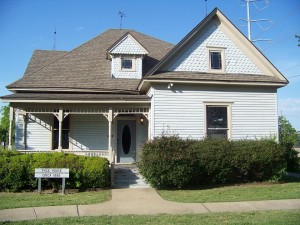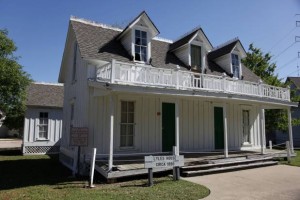Pace House Relocation More Than Just an Old Garland Home Project
More than just a saga about efforts to save two old houses, the controversy that erupted in spring 2013 over the city’s plans to demolish the Lyles and Pace Houses has been a much-needed catalyst to push Garland to take some needed steps in the arena of historic preservation. Had the bulldozers been allowed to move against the homes a year ago in May, Garland would have lost much, much more than just the two historic homes that the city owned.
Likewise, had the city quickly opted to spend more than $600,000 in borrowed funds to undo the imbroglio it created when it underestimated the public’s reaction that would ensue from its plans to raze the Lyles and Pace Houses to make way for more apartments, the victory would have been shallow and hollow. Just saving the Lyles and Pace Houses alone would not have stopped the bulldozers and the apathy in the rest of the historic downtown community toward its privately owned historic housing stock.
In 1982 the Texas Historical Commission surveyed the city to determine Garland’s inventory of historic homes. A quick follow-up I conducted a few months ago to learn the status of those homes revealed that somewhere between 25 to 30 percent of those historic beauties identified in the survey as historic and worth saving have been torn down and at least another 20 percent are lacking in the proper care they deserve to prevent their eventual demolition.
For four decades Garland’s leaders have puzzled over why the city’s historic downtown business area was crumbling so badly year by year. They may not have considered that the city’s own laisse-faire approach to historic homes in the downtown area could have been a major culprit. For whatever reason, the city allowed any institution or individual with title to any historic home to demolish it at will without taking into account what the destruction would do to surrounding homeowners or businesses—let alone to the whole community and to the business and tax base in downtown Garland.
When downtown was thriving some 40 years ago—yes, my wife, Kay, and I well remember those glory days—so were the nearby single-family housing communities in downtown Garland. Now that the vast majority of the single-family housing stock in the downtown area has been destroyed or lies in ruins, it doesn’t take a rocket scientist to figure out the correlation. The city today is spending tens of millions of taxpayer dollars on new apartments and other amenities trying to draw people back into the downtown area and revive an important but depleted part of the city which it for too long has ignored.
The Lyles and Pace Houses became the rallying cry for those of us who cherish this city’s history, want to see it preserved, and desire somehow to correct four decades of benign neglect and abuse. We are grateful for those who live outside the Downtown area that have joined in the crusade with the tiny group of us who still live in single-family homes in the downtown area.
The compromise plan hammered out over the long months of debate over the fate of the two historic houses now sets the stage to accomplish much, much more—and at a much fairer price tag to taxpayers—than had the city simply agreed to pay the original $600,000-plus that was debated.
The Lyles House rightfully will remain under city ownership. Under the leadership of Mayor Douglas Athas, City Council has agreed to spend $179,000 to move the home to an area that it once shied away from using—city-owned land next to the historic rail car and rail station in the new Walnut Corridor near the new Fourth Street Crossing. Its full and future restoration now rests in how a public/private partnership will be put together and will work to raise funds to restore the home into a museum of early Garland life.
The Pace House will go into private ownership. After a long and arduous bureaucratic journey the city is preparing to accept the only offer it had to keep the house in historic downtown. Other bonafide, written offers were to move the house to another Texas city and to some unidentified area in Garland.
Presuming City Council approves on June 17 the final resolution to this matter, my wife and I will spend nearly the same amount on the move and restoration of the Pace House that the city will spend on the Lyles House to relocate the 1895-vintage Pace home onto the one vacant lot remaining in our neighborhood in Garland’s first historic district, created on May 20 by a unanimous City Council action at the urging of all of our neighbors and us.
Our same neighborhood which unanimously petitioned City Council for the historic designation also enthusiastically supports our desire to adopt the Pace House into our neighborhood—the Travis College Hill Historic District, lying on South 11th Street (the original Garland Avenue!) between West Avenues B and D. We and our neighbors recognize that the relocation of the Pace House—to the center of our historic district—and its historicity and beauty will function as another “crown jewel” for our area, one of the few remaining intact neighborhoods in downtown Garland.
Unlike the Oaks organization that is building the new downtown apartments, Kay and I will get no financial help from the city to take this plunge. No tax abatement. No financial incentive. Nothing. Once the trailer bearing the Pace House begins its move from behind the Patty Granville Performing Arts Center, all costs and liability become our responsibility. We will even be paying the city’s many building permit fees that will be required, for the city’s street lights that will have to be temporarily moved during the relocation, and all the other associated costs—and then later the high privilege of paying taxes to the city, county and school district on the restored property. Not a bad deal at all for the city from a house it nearly bulldozed 13 months ago!
Why would we do this? Because we love Historic Downtown Garland and we love living here. We want to see the entire area revived, restored, and highly respected—and not torn down nor filled with apartments, used-car lots, church-parking lots, and the distant dream of more consumer-friendly businesses returning somehow, some way, some day to the downtown area.
The 1895 vintage Queen Anne-style Pace House will sit alongside our other historic homes, five of which date to 1915-1918 and the other five which date to the 1920s through 1960. (One additional home built in 2002 will join the rest of the houses in our neighborhood as “historic” in only 38 more years.)
Unlike its sister cities in the Dallas Metroplex and most cities its size and larger around the entire country, Garland has lagged woefully far, far behind in establishing preservation laws and guidelines for historic homes and other historic structures. For that reason Garland had already lost a significant chunk of its historic homes, with more targeted to join the march to the landfill.
I believe that based on their track records and other actions so far this year, our mayor and city council have the conviction and courage to now tackle the issue of historical preservation to its logical conclusion and a positive outcome. The door has now been opened so these leaders can walk through it without fighting a political firestorm and bring about a new era in Garland history where past and present merge in a beautiful marriage of mutual respect and harmony.
What makes our neighborhood different is that we voluntarily banded together, generated our own voluntary preservation standards, requested that City Council endorse our quest, and intend to continue to build the model for what Historic Downtown Garland really should have been like all along—and what it should look like in the future.
Our standards include Garland’s first-ever restrictions on the demolition of historic houses. These protect only the 11 houses currently in our district—and the umbrella will extend to the Pace House once it is in place—but could be used as a roadmap for other areas in the downtown area, nearby, or in other parts of Garland.
Government-sponsored, beautiful apartments are commendable, especially surrounding the new modern DART rail station and along Fourth and Fifth Streets, where the devastation was apparent to anyone arriving at the train stop in downtown. After four decades of neglect, some strong catalysts were necessary in those areas to get the economic and social engines firing again and to get this important job done in downtown.
The free enterprise system does work best, however, in areas like ours when city government recognizes its role of supporting and enabling citizens—such as those of us in our new Historic District—to keep and maintain their homes and helps them hold back the forces of destruction and evil that have ruined far too many other inner cities across the nation!















Social